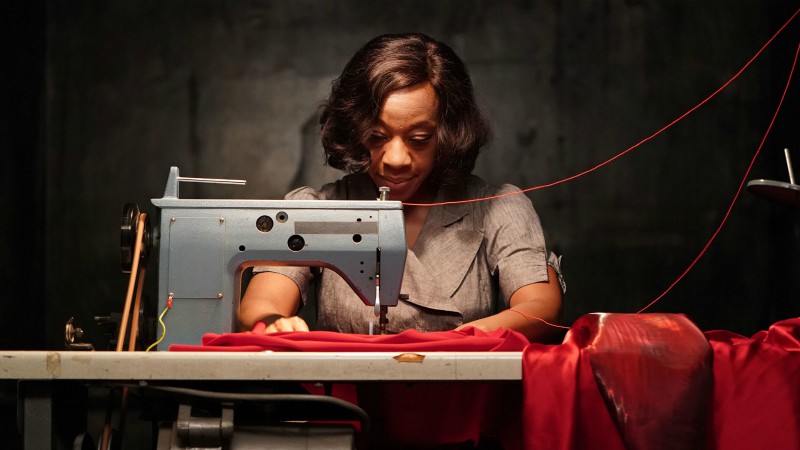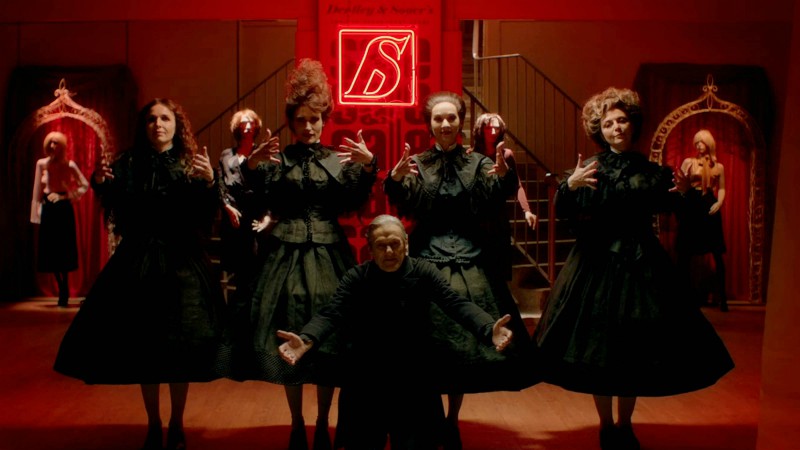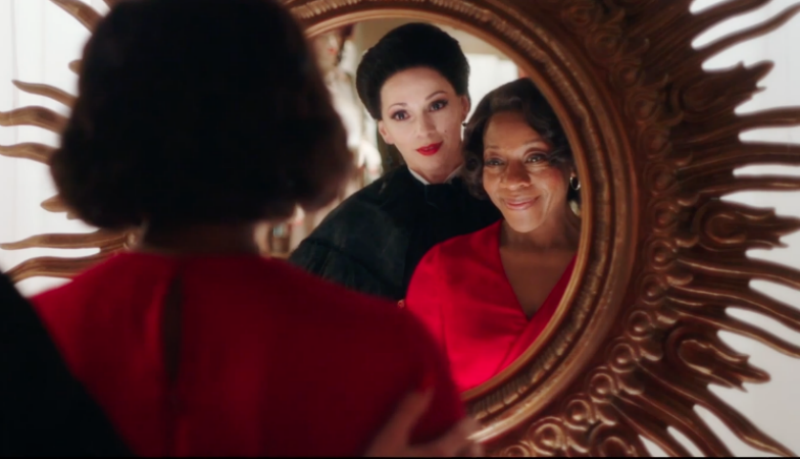British filmmaker Peter Strickland’s fourth feature film In Fabric stars Marianne Jean-Baptiste, Hayley Squires, Leo Bill, and Gwendoline Christie. Set mostly around an antiquated Thames Valley department store, the film follows the journey of a killer red dress from its first wearer to its last. Lavishly stylised, In Fabric sees Strickland flexing his inimitable style and challenging orthodoxy once again with satire and horror, this time exploring themes concerning consumerism and the rituals, superstitions and fetishes that surround clothes and retail culture.
Just as the film gets released on Curzon Home Cinema, Lara C. Cory had a word with the director in order to find out where his inspiration came from, the mythologies behind the movie aesthetics, his relation with music, working with Stereolab and much more!
…
.
Lara C. Cory – Please tell us about the department store that inspired the setting of this film? What elements particularly captured your imagination?
Peter Strickland – A department store in Reading called Jackson’s was the main inspiration for the film. Everything from its pneumatic money chutes to the mannequins was pivotal to the script I was writing. The film is essentially a childhood’s perspective of department stores, evoking the perceived mystery of these places when one is too young to know where a dumb waiter goes.
LCC – The film had an unusual story arc of two stories, one long, one short. Was this intentional or simply a result of budgetary limitations? How did you choose whose stories or which strands to follow?
PS – I did have more stories, but that all fell by the wayside. It ended up feeling strange with three victims, but in two stories. I could’ve incorporated more victims for the dress had I made each story shorter, but the problem with that is the characters feel more dispensable. I wanted the audience to relate to the characters and not want them to die, and by spending time with each character the audience hopefully connect more.

LCC – Talk us through some of the themes and mythologies that fed into the story and aesthetic of the film?
PS – The ultimate thing for me was to explore the darker side of our connection with clothing – unspoken fetishes, superstition, body dysmorphia, things that clothing often emphasises. I love the idea of an inert piece of fabric provoking such strong reactions in people. How a dead person’s clothing has its own haunted power. How another piece of clothing can disgust someone or turn them on. Clothing is this strange conduit between one human and another. Without the human imprint on it, clothing is not so interesting for me as a subject.
Of course, the allure of clothing and its aspirational or cosmetic ability to hide or reveal who you are is of relevance in the film, but ultimately, I was fascinated by the visceral nature of a human’s presence found in clothing and even in second-hand clothing. You can often smell the previous owner’s body odour in the armpits of jackets and shirts. If you dwell on it long enough, it’s a very bizarre form of proxy intimacy. All this is not exactly a mythology, but that was my preoccupation for the film.
LCC – The time-zones in the film felt rather fluid and difficult to pin down and I was told you gave the various crew members different time periods to work within. What can you tell me about this and the significance it has in the larger narrative?
PS – The film is set in January 1993 and only has one flashback to a man’s childhood in the 1970s in which an erotic twitch is ignited by a sales rep’s hosiery. What I loved about Jackson’s in Reading was the feeling of stepping into a different period and I wanted to maintain that anachronism with In Fabric. I didn’t give anyone different time periods. I gave numbers to the actors according to the reality of the environment they were appearing in. A one was close to social realism, while a nine was close to completely surreal.
LCC – There are some very disturbing scenes in this film, some explicit and some more subtle. How do you know how far you can push the boundaries when it comes to graphic bodily function? Do you ever worry about being gratuitous or are you waving the flag for uncensored self-expression?
PS – I don’t know about uncensored. I’d fully respect any individual’s choice to walk out of In Fabric or not see it, but that’s not for censors to decide. It’s an incredibly complex thing and censorship can only be on a case-by-case basis. It’s really hard to write about unless one writes an essay. I sound as if I’m contradicting myself and a lot of films I admire are extremely troubling or toxic, but there are things that I personally would find too distressing to see and in a world without a censorship body. You open up a Pandora’s box of transgressions way beyond what we’re already accustomed to. But when do things shift from an infinite variety of personal limits to something clearly defined as unacceptable?
In Fabric might push its eroticism into uncomfortable areas, but on a purely technical and legal level, all the ‘sex’ scenes in the film are consensual, which is why I feel this particular film shouldn’t be cut even though the cuts were minimal. I disagree with the US censor on In Fabric, but I’d still rather have a world in which I disagree with a censor than having no censorship at all. I find the normalisation of extreme violence in film far more troublesome than Fatma’s character from In Fabric tasting a bit of menstrual blood, but still – the vast majority of films with extreme violence shouldn’t be censored either.

LCC – In Fabric feels like a series of obfuscated mysteries more than a haunting tale with a traditional story arc, did you set out to tell such a diffuse and abstract tale? Does sharing only portions of the ‘bigger picture’ make for more intriguing cinema?
PS – To me, the film is not abstract, as long as one accepts that the dress is the protagonist and everyone else plays second fiddle to it. The characters are disposable, but that doesn’t mean I can’t invest all my love in them. The three victims of the dress might have their flaws, but I couldn’t write those characters if I didn’t believe in them or didn’t see something of myself or people close to me in them. That doesn’t really answer your question. Only sharing portions of the ‘bigger picture’ does make for a more intriguing cinematic experience, but I think In Fabric does share pretty generous portions, in which case it’s probably not an intriguing cinematic experience.
LCC – I really love the music in this film. I understand you engaged Tim Gane (of Stereolab) to work on the score before the film was made. Can you tell us some of the triggers or ideas that you gave him for the soundtrack and was there much adjusting to be done or did you find yourself bending to the will of the music as you wrote and shot the film?
PS – Tim initially made a series of long pieces for me to immerse myself in. There was no story at that point, but I knew I wanted to work with him. Some of the demos were remastered for the film and I didn’t want much to change there, but other pieces of music were created by Tim and the band after they saw the rushes. Sometimes the music would inform the images, such as with the ‘fire alarm’, which is a slight mutation of a demo Tim did for me several years back. Otherwise, it was a back and forth with Tim adjusting music for a scene and adjusting the edit for the music.
In terms of references, I tried to avoid them as much as possible. Of course, there were a few [musical] references, such as Merry Clayton, Mick Jagger and Bernard Parmegiani, but even then, we tried to allow ourselves to deviate as much as possible. A lot of our conversations were about mood and instruments. Tim suggested the celeste and that worked out really well.
Initially, we spoke a lot about the score being very drum-machine heavy, which felt quite cold and hard in a good way. Tim sent a lot of rhythms, but in the end, we didn’t use so many, as I eventually felt that cold and hard was not the way. I wanted something more romantic, but not to always use that music where you would expect it. The sex ritual with the mannequin has the film’s most romantic music (which was initially composed for the love scene with Sheila and Zach), but I really loved the counterpoint of that dark sexuality with lush, romantic music and the Sheila/Zach lovemaking with more ominous music. I wanted Tim to take the lead as much as possible. Of course, I had my thoughts and suggestions, but I can never tell a musician what notes to play and even if I could, there’d be no point in asking someone to do a score. When you ask someone to do a score, it’s important to remember why you asked them and not try and mould them into a Hans Zimmer or Ennio Morricone prototype.
Picture at the top of this article by Marek Szold. The other images are stills from In Fabric.










